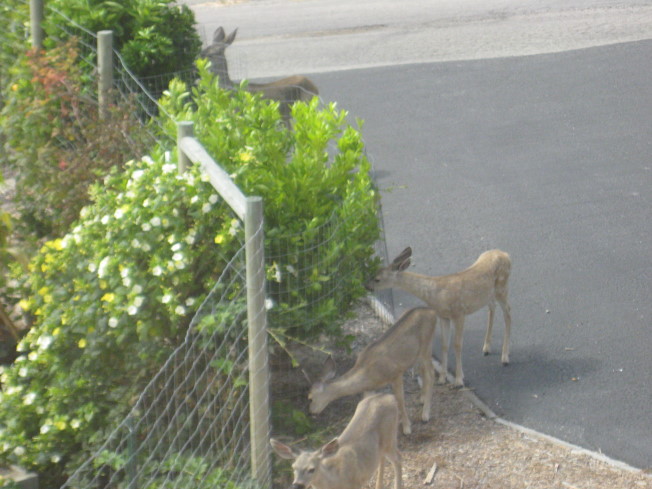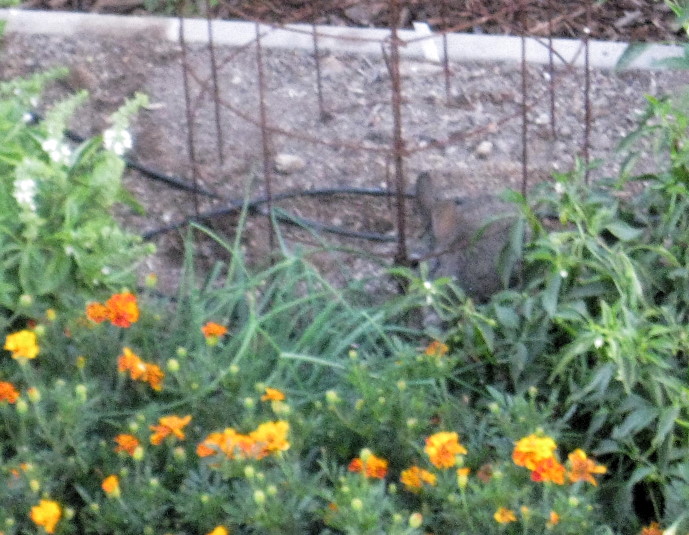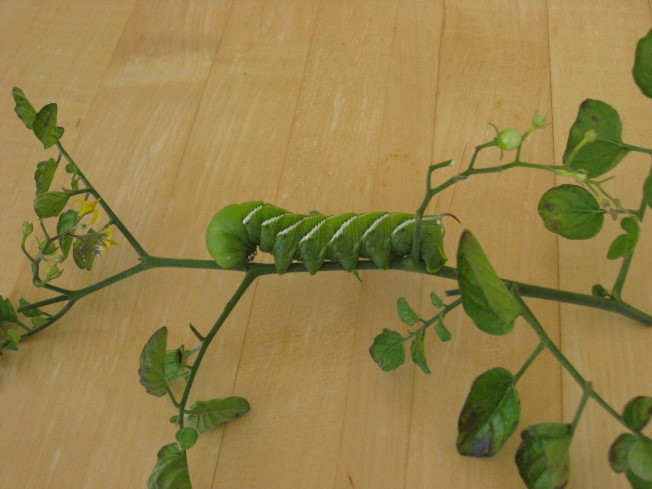Thee fawns came by and trimmed what they could reach. Their mom stayed on the driveway further from the house. They seem to be regular visitors to our home

Thee fawns came by and trimmed what they could reach. Their mom stayed on the driveway further from the house. They seem to be regular visitors to our home

An attempt at a fall crop of peas failed. The seeds germinated and then the seedlings disappeared. This photo had to be taken from inside the house, so things are a bit blurry. But if you look closely at the area just inside the wire cage, there is the reason why the seedlings failed — a little cottontail bunny was visiting the garden again.

I found this critter, a tomato hornworm in the current tomato plant. Just the one.

They are pretty, but not desirable in the garden. Apparently they can be a major problem for some gardeners. However, I have rarely seen any. When we lived in Saratoga I saw one in the garden there — in the mouth of a rather large lizard.
The “deer and rabbit” fencing we have around our garden mostly works. The deer do manage to poke their noses through the openings to munch on anything growing within a few inches of the fence. Only a few grape leaves, citrus branches and the blackberry and raspberry plants are in any danger of being pruned by Bambi. The thorns on the berries and some of the citrus do not seem to hinder the deer when anything is within reach.
At the bottom part of the fence, the one inch spacing in the wires does not seem to prevent the cottontail rabbits from slipping through without much difficulty. There are at least three bunnies in the group that lives near the garden. One was a bit smaller than the others, perhaps a juvenile who liked exploring more than staying near the safety of the brush area where they normally live. The pumpkin leaves provide excellent camouflage for the tiny bunny. Another of his favorite spots seemed to be among the bush beans — perhaps because they were a favorite for eating.
After multiple episodes of finding baby bunny in the garden and chasing him out, we hoped to put an end to it by installing a layer of chicken wire along the lower part of the fencing along the side next to the cottontail habitat. It did not work. We had hoped that they would not go around to the side. For a few days, it looked like a success. But all too soon, the cottontails were hopping around the garden again.
We will have to add the additional chicken wire to the other sides of the fence to keep the cottontails out. Fortunately, the damage they have done so far has been minimal — mostly a few beans and peas. Meanwhile, when I trim anything from the garden or remove past prime plants, the results are dumped outside the fence and serve as a buffet for the deer and rabbits.
The eight potted blueberry bushes started out the spring with lots of flowers. Small berries followed shortly. But there never seemed to be any that were properly ripe. Eventually I realized that it was not a case of being impatient. There were berries that were almost ripe. But very rarely any that were ready to pick.
Finally I discovered that I was being robbed. A very clever bluejay had discovered the berries and was picking them off as they ripened. When he could not find a perch that would allow him to reach what he wanted, he flew at the target, knocked it to the ground where he landed to enjoy his snack.
Now one blue jay was bad enough. But things got worse. A pair of robins appeared. We typically do not see robins around here since they tend to prefer more civilized landscapes in the suburbs with nicely manicured lawns where they can hunt worms. I suspect that a neighbor has succeeded in making the area around their house a little less rural and the robins found it suits them. Compared to the bluejay, the robins are little pigs and not at all afraid of the human approaching them. And they are sampling a lot of the other garden goodies as well.
If I am going to get more than an occasional blueberry, I will need to use bird netting to keep the fruit for my own use. The berries and leaves on the bushes are too small to simply drape the netting over the bushes. It will require a support that allows me access to harvest as well. In the long run I plan to have a couple of mulberry trees as offerings to the birds. In theory, they are supposed to prefer those to other berries and fruit. Of course, if the birds are not reading the same garden advice, the alternate plan “B” is to have so much growing that there is plenty for all of us to enjoy.